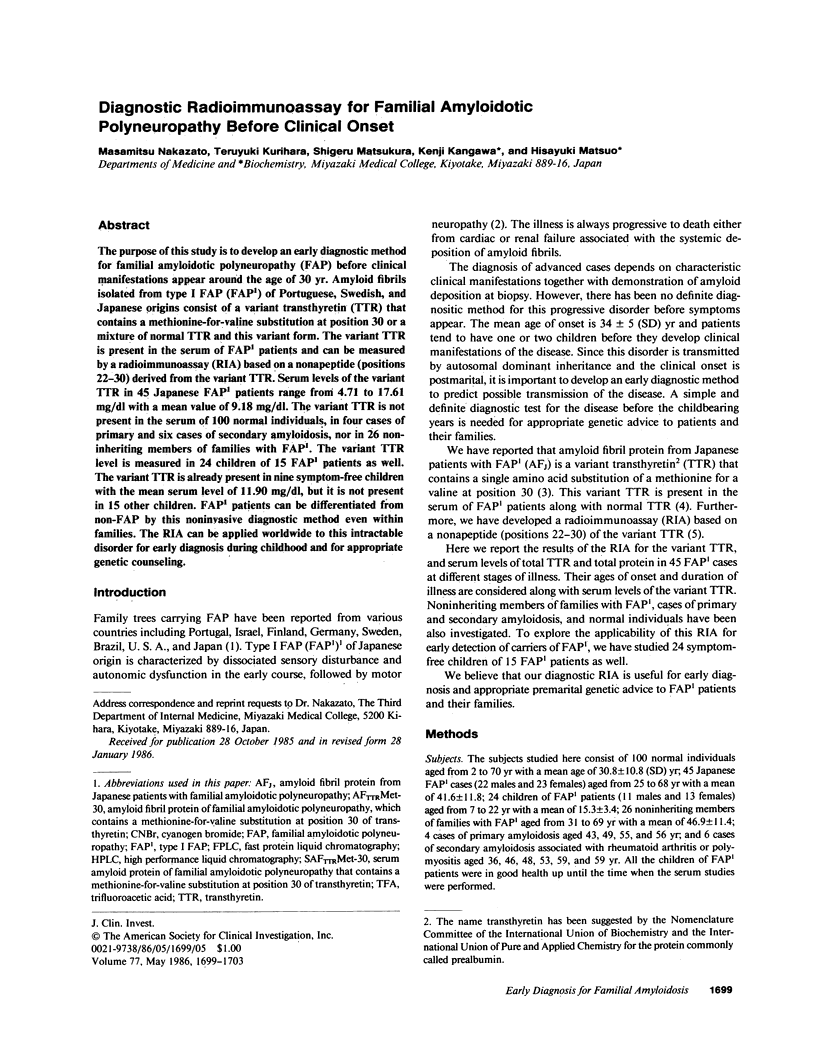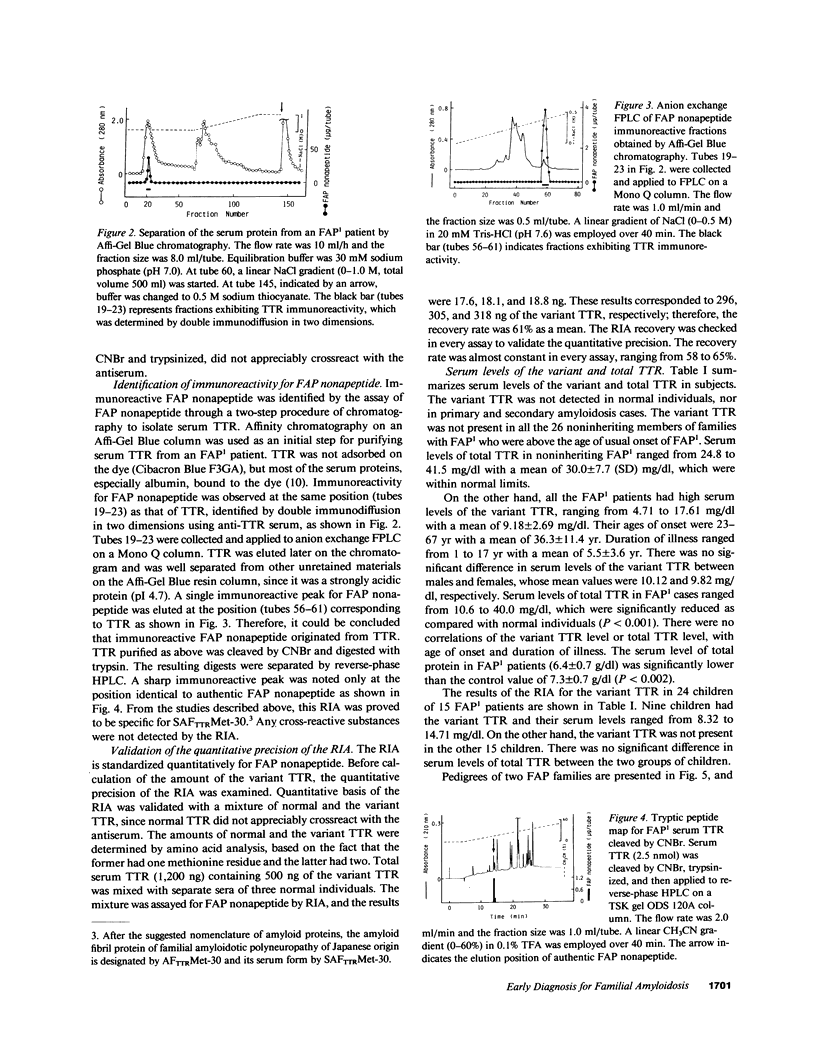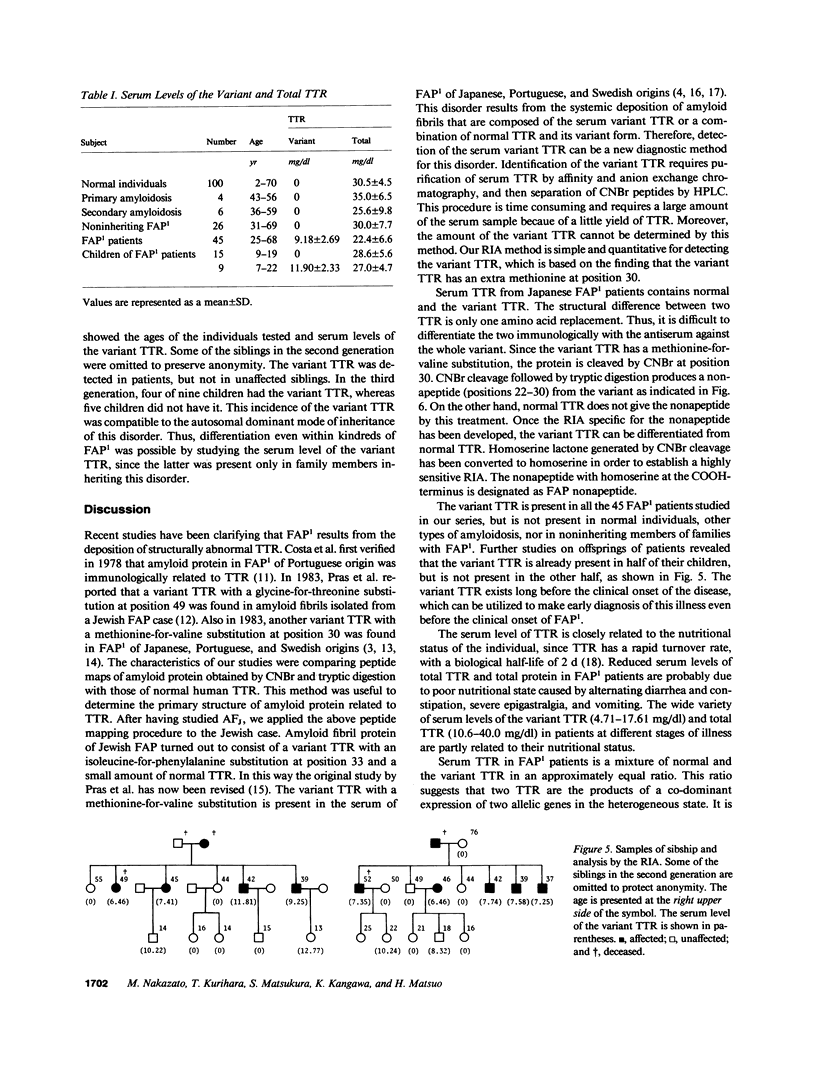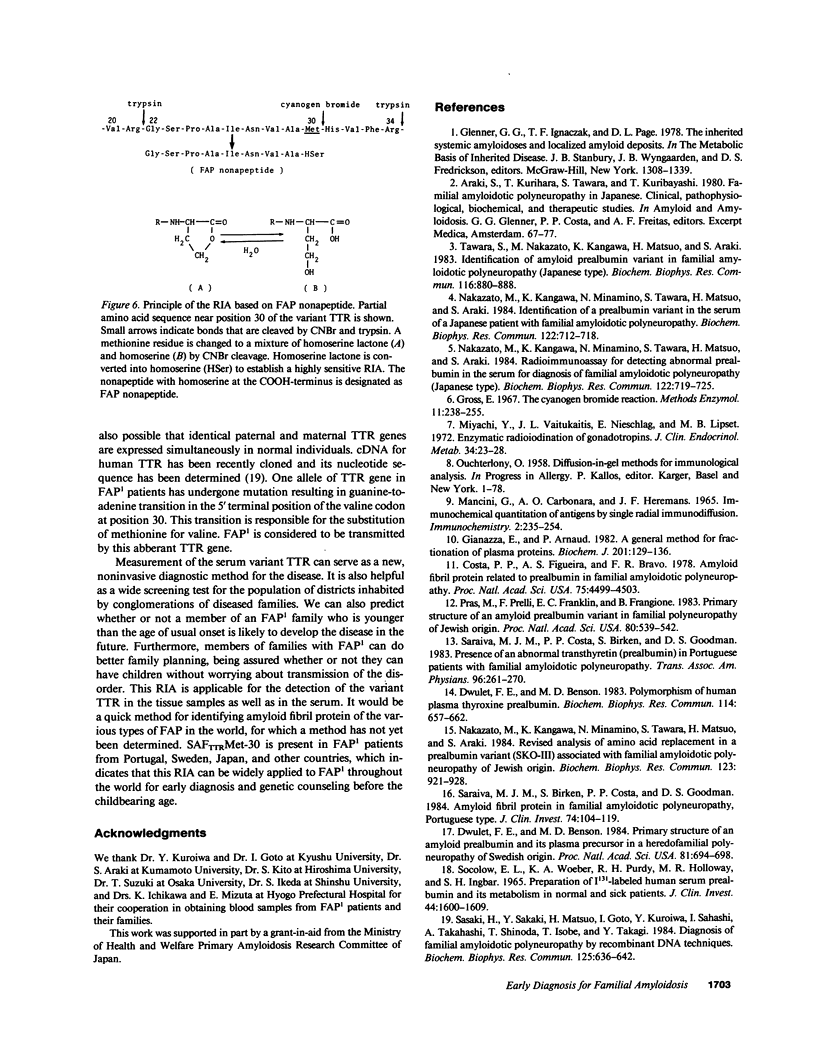Abstract
The purpose of this study is to develop an early diagnostic method for familial amyloidotic polyneuropathy (FAP) before clinical manifestations appear around the age of 30 yr. Amyloid fibrils isolated from type I FAP (FAP1) of Portuguese, Swedish, and Japanese origins consist of a variant transthyretin (TTR) that contains a methionine-for-valine substitution at position 30 or a mixture of normal TTR and this variant form. The variant TTR is present in the serum of FAP1 patients and can be measured by a radioimmunoassay (RIA) based on a nonapeptide (positions 22-30) derived from the variant TTR. Serum levels of the variant TTR in 45 Japanese FAP1 patients range from 4.71 to 17.61 mg/dl with a mean value of 9.18 mg/dl. The variant TTR is not present in the serum of 100 normal individuals, in four cases of primary and six cases of secondary amyloidosis, nor in 26 non-inheriting members of families with FAP1. The variant TTR level is measured in 24 children of 15 FAP1 patients as well. The variant TTR is already present in nine symptom-free children with the mean serum level of 11.90 mg/dl, but it is not present in 15 other children. FAP1 patients can be differentiated from non-FAP by this noninvasive diagnostic method even within families. The RIA can be applied worldwide to this intractable disorder for early diagnosis during childhood and for appropriate genetic counseling.
Full text
PDF




Selected References
These references are in PubMed. This may not be the complete list of references from this article.
- Costa P. P., Figueira A. S., Bravo F. R. Amyloid fibril protein related to prealbumin in familial amyloidotic polyneuropathy. Proc Natl Acad Sci U S A. 1978 Sep;75(9):4499–4503. doi: 10.1073/pnas.75.9.4499. [DOI] [PMC free article] [PubMed] [Google Scholar]
- Dwulet F. E., Benson M. D. Polymorphism of human plasma thyroxine binding prealbumin. Biochem Biophys Res Commun. 1983 Jul 29;114(2):657–662. doi: 10.1016/0006-291x(83)90831-8. [DOI] [PubMed] [Google Scholar]
- Dwulet F. E., Benson M. D. Primary structure of an amyloid prealbumin and its plasma precursor in a heredofamilial polyneuropathy of Swedish origin. Proc Natl Acad Sci U S A. 1984 Feb;81(3):694–698. doi: 10.1073/pnas.81.3.694. [DOI] [PMC free article] [PubMed] [Google Scholar]
- Gianazza E., Arnaud P. A general method for fractionation of plasma proteins. Dye-ligand affinity chromatography on immobilized Cibacron blue F3-GA. Biochem J. 1982 Jan 1;201(1):129–136. doi: 10.1042/bj2010129. [DOI] [PMC free article] [PubMed] [Google Scholar]
- Mancini G., Carbonara A. O., Heremans J. F. Immunochemical quantitation of antigens by single radial immunodiffusion. Immunochemistry. 1965 Sep;2(3):235–254. doi: 10.1016/0019-2791(65)90004-2. [DOI] [PubMed] [Google Scholar]
- Miyachi Y., Vaitukaitis J. L., Nieschlag E., Lipsett M. B. Enzymatic radioiodination of gonadotropins. J Clin Endocrinol Metab. 1972 Jan;34(1):23–28. doi: 10.1210/jcem-34-1-23. [DOI] [PubMed] [Google Scholar]
- Nakazato M., Kangawa K., Minamino N., Tawara S., Matsuo H., Araki S. Identification of a prealbumin variant in the serum of a Japanese patient with familial amyloidotic polyneuropathy. Biochem Biophys Res Commun. 1984 Jul 31;122(2):712–718. doi: 10.1016/s0006-291x(84)80092-3. [DOI] [PubMed] [Google Scholar]
- Nakazato M., Kangawa K., Minamino N., Tawara S., Matsuo H., Araki S. Radioimmunoassay for detecting abnormal prealbumin in the serum for diagnosis of familial amyloidotic polyneuropathy (Japanese type). Biochem Biophys Res Commun. 1984 Jul 31;122(2):719–725. doi: 10.1016/s0006-291x(84)80093-5. [DOI] [PubMed] [Google Scholar]
- Nakazato M., Kangawa K., Minamino N., Tawara S., Matsuo H., Araki S. Revised analysis of amino acid replacement in a prealbumin variant (SKO-III) associated with familial amyloidotic polyneuropathy of Jewish origin. Biochem Biophys Res Commun. 1984 Sep 28;123(3):921–928. doi: 10.1016/s0006-291x(84)80222-3. [DOI] [PubMed] [Google Scholar]
- OUCHTERLONY O. Diffusion-in-gel methods for immunological analysis. Prog Allergy. 1958;5:1–78. [PubMed] [Google Scholar]
- Pras M., Prelli F., Franklin E. C., Frangione B. Primary structure of an amyloid prealbumin variant in familial polyneuropathy of Jewish origin. Proc Natl Acad Sci U S A. 1983 Jan;80(2):539–542. doi: 10.1073/pnas.80.2.539. [DOI] [PMC free article] [PubMed] [Google Scholar]
- Saraiva M. J., Birken S., Costa P. P., Goodman D. S. Amyloid fibril protein in familial amyloidotic polyneuropathy, Portuguese type. Definition of molecular abnormality in transthyretin (prealbumin). J Clin Invest. 1984 Jul;74(1):104–119. doi: 10.1172/JCI111390. [DOI] [PMC free article] [PubMed] [Google Scholar]
- Saraiva M. J., Costa P. P., Birken S., Goodman D. S. Presence of an abnormal transthyretin (prealbumin) in Portuguese patients with familial amyloidotic polyneuropathy. Trans Assoc Am Physicians. 1983;96:261–270. [PubMed] [Google Scholar]
- Sasaki H., Sakaki Y., Matsuo H., Goto I., Kuroiwa Y., Sahashi I., Takahashi A., Shinoda T., Isobe T., Takagi Y. Diagnosis of familial amyloidotic polyneuropathy by recombinant DNA techniques. Biochem Biophys Res Commun. 1984 Dec 14;125(2):636–642. doi: 10.1016/0006-291x(84)90586-2. [DOI] [PubMed] [Google Scholar]
- Socolow E. L., Woeber K. A., Purdy R. H., Holloway M. T., Ingbar S. H. Preparation of I-131-labeled human serum prealbumin and its metabolism in normal and sick patients. J Clin Invest. 1965 Oct;44(10):1600–1609. doi: 10.1172/JCI105266. [DOI] [PMC free article] [PubMed] [Google Scholar]
- Tawara S., Nakazato M., Kangawa K., Matsuo H., Araki S. Identification of amyloid prealbumin variant in familial amyloidotic polyneuropathy (Japanese type). Biochem Biophys Res Commun. 1983 Nov 15;116(3):880–888. doi: 10.1016/s0006-291x(83)80224-1. [DOI] [PubMed] [Google Scholar]


